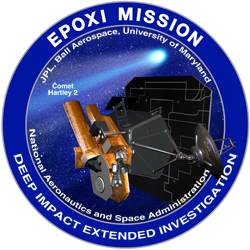EPOXI
Two intriguing investigations -- One flight-proven spacecraft
News: NASA Mission 'E-Minus' One Month to Comet Flyby, 2010.10.04
Press Release
NASA Mission 'E-Minus' One Month to Comet Flyby2010.10.04
 Click for full size image.
Click for full size image.
Logo of NASA's EPOXI mission, which is just one month away from its encounter with comet Hartley 2.
Credit: NASA/JPL-Caltech/UMD
PASADENA, Calif. - Fans of space exploration are familiar with the term T-minus, which NASA uses as a countdown to a rocket launch. But what of those noteworthy mission events where you already have a spacecraft in space, as with the upcoming flyby of a comet?
"We use 'E-minus' to help with our mission planning," said Tim Larson, EPOXI mission project manager at NASA's Jet Propulsion Laboratory in Pasadena, Calif. "The 'E' stands for encounter, and that is exactly what is going to happen one month from today, when our spacecraft has a close encounter with comet Hartley 2."
The EPOXI mission's Nov. 4 encounter with Hartley 2 will be only the fifth time in history that a comet has been imaged close-up. At point of closest approach, the spacecraft will be about 700 kilometers (435 miles) from the comet.
"Hartley 2 better not blink, because we'll be screaming by at 12.3 kilometers per second (7.6 miles per second)," said Larson.
One month out, the spacecraft is closing the distance with the comet at a rate of 976,000 kilometers (607,000 miles) per day. As it gets closer, the rate of closure will increase to a little over 1,000,000 kilometers (620,000 miles) per day.
For those interested in what the "T-minus" stands for in a NASA countdown to a rocket launch - it translates to "Time-minus." For example, when a rocket is getting ready for liftoff, it will be lifting off at a specific time. If that time is 45 seconds away, it is said to be "T-minus 45 seconds and counting."
EPOXI is an extended mission that utilizes the already "in-flight" Deep Impact spacecraft to explore distinct celestial targets of opportunity. The name EPOXI itself is a combination of the names for the two extended mission components: the extrasolar planet observations, called Extrasolar Planet Observations and Characterization (EPOCh), and the flyby of comet Hartley 2, called the Deep Impact Extended Investigation (DIXI). The spacecraft will continue to be referred to as "Deep Impact."
NASA's Jet Propulsion Laboratory, Pasadena, Calif., manages the EPOXI mission for NASA's Science Mission Directorate, Washington. The University of Maryland, College Park, is home to the mission's principal investigator, Michael A'Hearn. Drake Deming of NASA's Goddard Space Flight Center, Greenbelt, Md., is the science lead for the mission's extrasolar planet observations. The spacecraft was built for NASA by Ball Aerospace & Technologies Corp., Boulder, Colo. For more information about EPOXI visit http://epoxi.astro.umd.edu/ .
DC Agle
Jet Propulsion Laboratory, Pasadena, Calif
818-393-9011
agle [at] jpl [dot] nasa [dot] gov
RELEASE: 2010-321, Source
